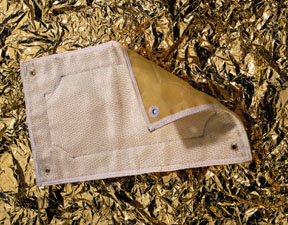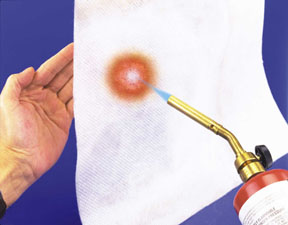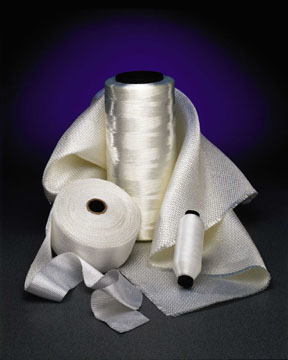Solutions for Hot Situations
From the company that brought the world an integral heating and cooling food service system after originally developing it for NASA's Apollo Program, comes yet another orbital offshoot: a product that can be as thin as paper and as strong as steel.
Nextel™ Ceramic Textiles and Composites from 3M Company offer space-age protection and innovative solutions for "hot situations," ranging from NASA to NASCAR. With superior thermal protection, Nextel fabrics, tape, and sleevings outperform other high-temperature textiles such as aramids, carbon, glass, and quartz, permitting engineers and manufacturers to handle applications up to 2,500 ºF (1,371 ºC). The stiffness and strength of Nextel Continuous Ceramic Fibers make them a great match for improving the rigidity of aluminum in metal matrix composites. Moreover, the fibers demonstrate low shrinkage at operating temperatures, which allow for the manufacturing of a dimensionally stable product. These novel fibers also offer excellent chemical resistance, low thermal conductivity, thermal shock resistance, low porosity, and unique electrical properties.
The origins of Nextel Ceramic Textiles and Composites reach all the way back to the early days of the Space Shuttle Program, when NASA scientists were tasked with improving high-temperature tiles and textiles to withstand the intense heat and pressures of reentry. Through research and testing, the ceramic fibers that are the framework for St. Paul, Minnesota-based 3M's Nextel technology proved to be suitable for use in the composition of the Shuttle's underbelly tiles. As the Space Shuttle Program progressed, the fibers were also woven into sleeving and fabric for use in gap fillers, flexible insulation blankets, heat shields, gaskets, and seals.
More recently, extensive testing by NASA researchers at the Marshall Space Flight Center and the Johnson Space Center demonstrated Nextel's value as a vital component in the development of a strong, lightweight meteoroid/space debris shield known as a "Stuffed Whipple Shield." This technology, which also encompasses the nylon-like Kevlar® polymer from DuPont, is currently being used to safeguard the International Space Station and the RADARSAT spacecraft from inevitable contact with space debris. The results from the hypervelocity impact testing at Marshall and Johnson showed that Nextel Ceramic Textiles and Composites improve shield performance, when compared to aluminum, because they are "better at shocking projectile fragments," and sustain far less damage after an impact with the debris.
3M and NASA's contribution to improving upon conventional aluminum shielding methods is playing a major role in protecting vehicles, payloads, and crew members by fending off the debris, which continues to generate over time. According to recently published reports consistent with information offered by Johnson's Space Science Enterprise, space launches occurring over the last 40 years have led to more than 23,000 observable objects larger than 10 centimeters, 7,500 of which are still in orbit. These reports also show that in 2000, there were between 70,000 and 120,000 "on-orbit" debris fragments (not attributed to launches, satellites, or mission-related objects) larger than 1 centimeter floating in space.
At the same time 3M was meeting NASA's needs for the development of lightweight textile materials, the company was introducing the Nextel technology to private industry. In commercial aviation, Nextel Flame Stopping Dot Paper provides superior performance for fuselage burn-through protection. Private aircraft, such as the team plane for the National Basketball Association's Miami Heat, also rely on the flame-stopping technology.
Despite its paper-thin characteristics, Nextel Dot Paper withstands fire without burning or shrinking. The unique "dots" help to maintain the paper's integrity and flexibility. Testing at the Federal Aviation Administration's William J. Hughes Technical Center shows that the Flame Stopping Dot Paper resists flame penetration for greater than 4 minutes at a temperature of 2,000 ºF (1,093 ºC). In addition to fuselage burn-through applications, Nextel Dot Paper can be used for added protection in galleys, cockpits, cargo bays, firewalls, fire doors, ducting, insulators, gaskets, seals, and fire-resistant storage.
The petrochemical industry is using flexible tube seals fabricated from Nextel Ceramic Textiles and Composites to save energy and improve control over high-temperature chemical processes. For example, the M.W. Kellogg Company, of Houston, Texas, adopted Nextel ceramic tape in the construction of a circulating-bed transport reactor. By choosing Nextel materials, M.W. Kellogg now offers refineries a cleaner form of gas production that creates less pollution and hazardous waste than previous technologies.
When used in industrial furnaces, Nextel woven fabrics can also serve as thermal barriers to separate different temperature zones while preventing particulate shedding. Nextel ceramic sleevings modeled after doorgaskets and seals developed for the Space Shuttle are used to seal doors and other access panels on the furnaces.
The Nextel product also helps NASCAR teams reduce the heat transfer from engine, exhaust, and track surface into the driver's compartment. Race car drivers routinely face ambient cockpit temperatures of 115 ºF (46 ºC) or more and floorboard temperatures hot enough to boil water. Lightweight Nextel Thermal Barriers effectively block heat before it gets into the vehicle. Tested during the 1999 season on NASCAR Winston Cup and Craftsman Truck Series vehicles, the thermal barriers are now used on Winston Cup, Busch Grand National, and Craftsman Truck vehicles to reduce driver compartment temperature by more than 70 ºF (21 ºC).
Nextel™ is a trademark of 3M Company.
Kevlar® is a registered trademark of E.I. du Pont de Nemours and Company.

Extensive testing by NASA researchers at the Marshall Space Flight Center and the Johnson Space Center demonstrated Nextel's™ value as a vital component in the development of a strong, lightweight meteoroid/space debris shield known as a "Stuffed Whipple Shield." Images courtesy of 3M Company (www.3m.com).

Nextel™ Flame Stopping Dot Paper resists flame penetration for greater than 4 minutes at a temperature of 2,000 °F.

With superior thermal protection, the Nextel™ family of products outperforms other high-temperature textiles such as aramids, carbon, glass, and quartz.













